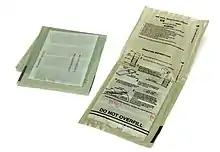
A flameless ration heater (FRH), colloquially an MRE heater, is a form of self-heating food packaging included in U.S. military Meal, Ready-to-Eat (MRE) rations (since the early 1990s) or similar rations, capable of raising the temperature of an 8-ounce (230 g) entrée (main course) by 100 °F (38 °C) in twelve minutes, which has no visible flame.[1]
The ration heater contains finely powdered magnesium metal, alloyed with a small amount of iron and table salt. To activate the reaction, a small amount of water is added, and the boiling point of water is quickly reached as the exothermic reaction proceeds.[2]
Chemical reaction

Ration heaters generate heat in an electron-transfer process called an oxidation-reduction reaction. Water oxidizes magnesium metal, according to the following chemical reaction:
- Mg + 2H2O → Mg(OH)2 + H2 [+ heat (q)]
This reaction is analogous to iron being rusted by oxygen, and proceeds at about the same slow rate, which is too slow to generate usable heat. To accelerate the reaction, metallic iron particles and table salt (NaCl) are mixed with the magnesium particles.[3][4][5]
Iron and magnesium metals, when suspended in an electrolyte, form a galvanic cell that can generate electricity. When water is added to a ration heater, it dissolves the salt to form a salt-water electrolyte, thereby turning each particle of magnesium and iron into a tiny battery. Because the magnesium and iron particles are in contact, they essentially become thousands of tiny short-circuited batteries which quickly burn out, producing heat in a process the patent holders call "supercorroding galvanic cells".
One brand of self-heating rations uses 7.5 grams of a powdered magnesium-iron alloy, consisting of 95% magnesium and 5% iron by weight, 0.5 grams of salt, in addition to an inert filler and anti-foaming agent. Upon adding one US fluid ounce (30 ml) of water, this mixture can raise the temperature of a 8-ounce (230 g) meal packet by 100 °F (38 °C) in about 10 minutes, releasing approximately 50 kilojoules (47 BTU) of heat energy at about 80 watts.[6]
Aluminum-based heaters contain sodium hydroxide and the sodium aluminate byproduct are both dangerous if incidentally consumed. Aluminum-based heaters are advertised as being magnesium-free, with the implication that they do not produce hydrogen gas. However these implications are false. In theory, the reaction of the Aluminum-based heater follows the reaction below:
- 2 Al + 2 NaOH + 6H2O→ 3 H2+ 2 AlNa(OH)4 [+ heat (q)]
Approximately 12.4L of H2 gas per 25 gram heater is produced. The reaction of the Magnesium-based heater approximately 10.0L of H2 gas per 12 gram heater is produced.
Confined space hazard
The United States Department of Transportation (DOT) Federal Aviation Administration (FAA) conducted testing and released a report which in summary states "... the release of hydrogen gas from these flameless ration heaters is of a sufficient quantity to pose a potential hazard on board a passenger aircraft."[7] This testing was performed on commercial grade 'heater meals' which consisted of an unenclosed flameless heat pouch, a bag of salt water, a styrofoam saucer/tray and a meal in a sealed, microwavable/boilable bowl.
Disposal
MRE heaters that have not been properly activated must be disposed of as hazardous waste. Disposing of an un-activated MRE heater in a solid waste container is against United States law. Un-activated MRE heaters pose a potential fire hazard if they become wet when turned in at a landfill site. MRE heaters must be disposed of in approved solid waste containers aboard the installation after they have been properly activated.[8] The FRH can be disposed of as household waste after it is activated and cools down.[9]
See also
References
- ↑ Clark, James (12 September 2016). "Here's the ridiculous true story behind a 'Rock or Something'". Task & Purpose. Retrieved 16 October 2023.
- ↑ Brain, Marshall (15 April 2003). "How MREs Work". Howstuffworks. Retrieved 12 September 2014.
- ↑ Scott, Dan (February 1992). "Hot Meals" (PDF). Chem Matters. Archived from the original (PDF) on 12 July 2020. Retrieved 12 September 2014.
- ↑ US patent 4017414, Stanley A. Black & James F. Jenkins, "Powdered metal source for production of heat and hydrogen gas", published 1977-04-12, assigned to The United States Of America As Represented By The Secretary Of The Navy
- ↑ US patent 4264362, Sergius S. Sergev, Stanley A. Black, James F. Jenkins, "Supercorroding galvanic cell alloys for generation of heat and gas", published 1981-04-28, assigned to The United States Of America As Represented By The Secretary Of The Navy
- ↑ US patent 5611329, Marc Lamensdorf, "Flameless heater and method of making same", published 1997-03-18, assigned to Truetech, Inc.
- ↑ Summer, Steven M. (June 2006). "The Fire Safety Hazard of the Use of Flameless Ration Heaters Onboard Commercial Aircraft, DOT/FAA/AR-TN06/18" (PDF). Federal Aviation Administration. Retrieved 9 March 2008.
- ↑ "MRE (Meal, Ready-to-Eat) Heater Disposal" (PDF). Marine Corps Air Station Miramar. 29 August 2007. Retrieved 16 October 2023.
- ↑ "How to safely use a Flameless Ration Heater". luxfermagtech.com. 4 August 2021. Retrieved 16 October 2023.
